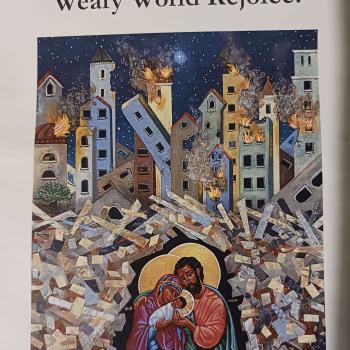The French have a marvelous turn of phrase “l’esprit de l’escalier” which might best be translated as “staircase wit.” It is used to refer to those situations where you think of the perfect retort far too late to say it—e.g., on the stairs as you are leaving. I think of this because I ran across a passage from Blessed John Henry Newman that I wish I had seen when we were discussing the revised translation of the Missal.
One of the changes at the time was to replace “seen and unseen” with “visible and invisible”, a change that I thought was a distinction without a difference and that was only done to make the new translation conform more literally to the underlying Latin text. I ran across some explanations, such as this one by Legionary of Christ Father Edward McNamara, professor of liturgy at the Regina Apostolorum university:
I believe that the literal rendition “visible and invisible” is not only more accurate than “seen and unseen” but also better reflects the philosophical and theological history behind the use of these terms.
In Christian philosophy and theology an invisible creature pertains to the spiritual realm beyond physical reality.
In this sense, “invisible” is not synonymous with “unseen.” If I were to hide behind a curtain, I would be unseen, but I would certainly not be invisible. Even the fictional “Invisible Man” felt hot and cold and would bleed if he stepped on a nail.
We sometimes use the term “invisible” to refer to physical realities in the infrared or ultraviolet spectrum shielded from our normal vision, or to radiation, radio waves and all sorts of forces. All of these realities pertain to the physical world, and although they are unseen by our eyes they are detectable and measurable by specialized instruments. Hence, philosophically and theologically they might be unseen but are not invisible.
The new translation of the creed, in using the term “invisible,” affirms with greater clarity the reality of the spiritual realm beyond the physical. This reality is explained in the Catechism of the Catholic Church (even though this work obviously refers to the former translation of the creed).
I just didn’t buy this argument but could not think of an appropriate response. But today, getting caught up on back Gospel readings from Daily Gospel Online I found a marvelous quote from Newman, from his sermon “The Invisible World”:
That they form a part of our unseen world, appears from the vision seen by the patriarch Jacob (Gn 28,10f.)… How little did he think that there was any thing very wonderful in this spot! It looked like any other spot. It was a lone, uncomfortable place…. Yet how different was the truth! Jacob saw but the world that is seen; he saw not the world that is not seen; yet the world that is not seen was there. It was there, though it did not at once make known its presence, but needed to be supernaturally displayed to him. He saw it in his sleep. “He dreamed, and behold, a ladder set up on the earth, and the top of it reached up to heaven; and behold, the Angels of God ascending and descending on it. And behold, the Lord stood above it.”
So it would seem that for a theologian of Newman’s acumen, there was no functional difference between the words “unseen” and “invisible”. Now it could be the case that there was no such distinction (or a different one) in 19th century English, but now this distinction holds in modern English. But the fact that we can still refer to “The Invisible Man” (as Fr. McNamara does) and do not feel obliged to say “The Unseen Man” since he is still part of our physical reality suggests otherwise.
So with l’esprit de l’escalier: if “seen and unseen” was good enough for Blessed Newman, I think it should be good enough for us!
















